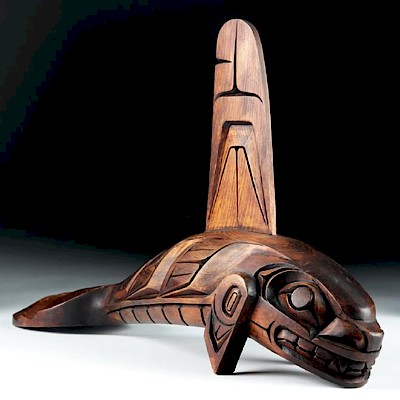Ancient Alaskan Bone Anthropomorphic Figure
Lot 1b
About Seller
Artemis Fine Arts
686 S Taylor Ave, Ste 106
Louisville, CO 80027
United States
Selling antiquities, ancient and ethnographic art online since 1993, Artemis Gallery specializes in Classical Antiquities (Egyptian, Greek, Roman, Near Eastern), Asian, Pre-Columbian, African / Tribal / Oceanographic art. Our extensive inventory includes pottery, stone, metal, wood, glass and textil...Read more
Estimate:
$1,250 - $1,650
Absentee vs Live bid
Two ways to bid:
- Leave a max absentee bid and the platform will bid on your behalf up to your maximum bid during the live auction.
- Bid live during the auction and your bids will be submitted real-time to the auctioneer.
Bid Increments
| Price | Bid Increment |
|---|---|
| $0 | $25 |
| $300 | $50 |
| $1,000 | $100 |
| $2,000 | $250 |
| $5,000 | $500 |
| $10,000 | $1,000 |
| $20,000 | $2,500 |
| $50,000 | $5,000 |
| $100,000 | $10,000 |
| $200,000 | $20,000 |
About Auction
By Artemis Fine Arts
May 24, 2018
Set Reminder
2018-05-24 10:00:00
2018-05-24 10:00:00
America/New_York
Bidsquare
Bidsquare : Northwest Coast, Tribal, & Pre-Columbian Art
https://www.bidsquare.com/auctions/artemis-gallery/northwest-coast-tribal-pre-columbian-art-3238
Featuring Pacific Northwest Coast Native American Art from respected collector / dealer, Joseph Alphabet. Artemis Fine Arts info@artemisgallery.com
Featuring Pacific Northwest Coast Native American Art from respected collector / dealer, Joseph Alphabet. Artemis Fine Arts info@artemisgallery.com
- Lot Description
Native American, probably Alaska, ca. 1000 to 1700 CE. A haunting miniature anthropomorphic figure, hand-carved from a marine mammal bone, probably walrus. The figure stands crouched, knees slightly bent, with his arms similarly bent; his one remaining hand is shown with the palm upward, mirroring the shape of the feet. The figure's head is oversized for its body, with deeply drilled, round eyes set close together around a long, thin nose, a small slit for a mouth, and a bun-like projection on the top of the figure's head. A hole drilled diagonally upward just above the groin may indicate that the piece once had a detachable phallus or may represent a belly button. The surface has a rich, dark patina that showcases the structure of the bone. Size: 1" W x 3" H (2.5 cm x 7.6 cm); 4.95" H (12.6 cm) on included custom stand.
For thousands of years and across the thousands of miles that encompass the Arctic world, people have carved miniatures from bone, antler, and ivory. Many seem to have been used as toggles, amulets, or charms, while, in the past, many also seem to have had shamanic power. In indigenous Arctic cosmology, all living beings have a "tarniq" or a "tarninga" which means a shade or image that is, literally, a tiny human or tiny animal with the same appearance. This is comparable to the Western idea of a soul. If the living being was somehow separated from his or her tarniq, they would fall ill, and, without shamanic intervention, ultimately die. This concept of a miniature representing a soul seems intimately linked with the practice of creating miniatures.
Provenance: private Newport Beach, California, USA collection; ex-Nasser Tribal Art Gallery, New York, USA
All items legal to buy/sell under U.S. Statute covering cultural patrimony Code 2600, CHAPTER 14, and are guaranteed to be as described or your money back.
A Certificate of Authenticity will accompany all winning bids.
We ship worldwide and handle all shipping in-house for your convenience.
#133619Rich, smooth patina. One arm is missing at the elbow. There may have once been a phallus that is lost.Condition
- Shipping Info
-
All shipping is handled in-house for your convenience. Your invoice from Artemis Gallery will include shipping calculation instructions. If in doubt, please inquire BEFORE bidding for estimated shipping costs for individual items.
-
- Buyer's Premium



 EUR
EUR CAD
CAD AUD
AUD GBP
GBP MXN
MXN HKD
HKD CNY
CNY MYR
MYR SEK
SEK SGD
SGD CHF
CHF THB
THB
















